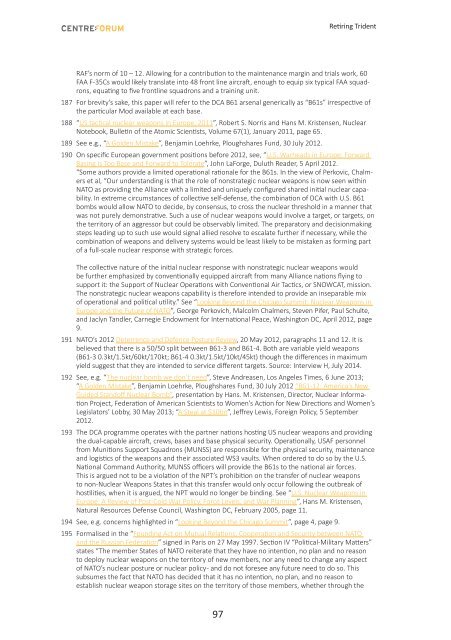Retiring Trident
retiring-trident
retiring-trident
You also want an ePaper? Increase the reach of your titles
YUMPU automatically turns print PDFs into web optimized ePapers that Google loves.
<strong>Retiring</strong> <strong>Trident</strong><br />
RAF’s norm of 10 – 12. Allowing for a contribution to the maintenance margin and trials work, 60<br />
FAA F-35Cs would likely translate into 48 front line aircraft, enough to equip six typical FAA squadrons,<br />
equating to five frontline squadrons and a training unit.<br />
187 For brevity’s sake, this paper will refer to the DCA B61 arsenal generically as “B61s” irrespective of<br />
the particular Mod available at each base.<br />
188 “US tactical nuclear weapons in Europe, 2011”, Robert S. Norris and Hans M. Kristensen, Nuclear<br />
Notebook, Bulletin of the Atomic Scientists, Volume 67(1), January 2011, page 65.<br />
189 See e.g., “A Golden Mistake”, Benjamin Loehrke, Ploughshares Fund, 30 July 2012.<br />
190 On specific European government positions before 2012, see, “U.S. Warheads in Europe: Forward<br />
Basing Is Too Base and Forward to Tolerate”, John LaForge, Duluth Reader, 5 April 2012.<br />
“Some authors provide a limited operational rationale for the B61s. In the view of Perkovic, Chalmers<br />
et al, “Our understanding is that the role of nonstrategic nuclear weapons is now seen within<br />
NATO as providing the Alliance with a limited and uniquely configured shared initial nuclear capability.<br />
In extreme circumstances of collective self-defense, the combination of DCA with U.S. B61<br />
bombs would allow NATO to decide, by consensus, to cross the nuclear threshold in a manner that<br />
was not purely demonstrative. Such a use of nuclear weapons would involve a target, or targets, on<br />
the territory of an aggressor but could be observably limited. The preparatory and decisionmaking<br />
steps leading up to such use would signal allied resolve to escalate further if necessary, while the<br />
combination of weapons and delivery systems would be least likely to be mistaken as forming part<br />
of a full-scale nuclear response with strategic forces.<br />
The collective nature of the initial nuclear response with nonstrategic nuclear weapons would<br />
be further emphasized by conventionally equipped aircraft from many Alliance nations flying to<br />
support it: the Support of Nuclear Operations with Conventional Air Tactics, or SNOWCAT, mission.<br />
The nonstrategic nuclear weapons capability is therefore intended to provide an inseparable mix<br />
of operational and political utility.” See “Looking Beyond the Chicago Summit: Nuclear Weapons in<br />
Europe and the Future of NATO”, George Perkovich, Malcolm Chalmers, Steven Pifer, Paul Schulte,<br />
and Jaclyn Tandler, Carnegie Endowment for International Peace, Washington DC, April 2012, page<br />
9.<br />
191 NATO’s 2012 Deterrence and Defence Posture Review, 20 May 2012, paragraphs 11 and 12. It is<br />
believed that there is a 50/50 split between B61-3 and B61-4. Both are variable yield weapons<br />
(B61-3 0.3kt/1.5kt/60kt/170kt; B61-4 0.3kt/1.5kt/10kt/45kt) though the differences in maximum<br />
yield suggest that they are intended to service different targets. Source: Interview H, July 2014.<br />
192 See, e.g. “The nuclear bomb we don’t need”, Steve Andreasen, Los Angeles Times, 6 June 2013;<br />
“A Golden Mistake”, Benjamin Loehrke, Ploughshares Fund, 30 July 2012 “B61-12: America’s New<br />
Guided Standoff Nuclear Bomb”, presentation by Hans. M. Kristensen, Director, Nuclear Information<br />
Project, Federation of American Scientists to Women’s Action for New Directions and Women’s<br />
Legislators’ Lobby, 30 May 2013; “A Steal at $10bn”, Jeffrey Lewis, Foreign Policy, 5 September<br />
2012.<br />
193 The DCA programme operates with the partner nations hosting US nuclear weapons and providing<br />
the dual-capable aircraft, crews, bases and base physical security. Operationally, USAF personnel<br />
from Munitions Support Squadrons (MUNSS) are responsible for the physical security, maintenance<br />
and logistics of the weapons and their associated WS3 vaults. When ordered to do so by the U.S.<br />
National Command Authority, MUNSS officers will provide the B61s to the national air forces.<br />
This is argued not to be a violation of the NPT’s prohibition on the transfer of nuclear weapons<br />
to non-Nuclear Weapons States in that this transfer would only occur following the outbreak of<br />
hostilities, when it is argued, the NPT would no longer be binding. See “U.S. Nuclear Weapons in<br />
Europe: A Review of Post-Cold War Policy, Force Levels, and War Planning”, Hans M. Kristensen,<br />
Natural Resources Defense Council, Washington DC, February 2005, page 11.<br />
194 See, e.g. concerns highlighted in “Looking Beyond the Chicago Summit”, page 4, page 9.<br />
195 Formalised in the “Founding Act on Mutual Relations, Cooperation and Security between NATO<br />
and the Russian Federation” signed in Paris on 27 May 1997. Section IV “Political-Military Matters”<br />
states “The member States of NATO reiterate that they have no intention, no plan and no reason<br />
to deploy nuclear weapons on the territory of new members, nor any need to change any aspect<br />
of NATO’s nuclear posture or nuclear policy - and do not foresee any future need to do so. This<br />
subsumes the fact that NATO has decided that it has no intention, no plan, and no reason to<br />
establish nuclear weapon storage sites on the territory of those members, whether through the<br />
97




